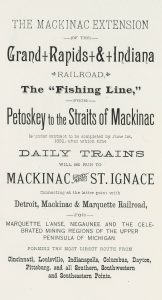
Although platted in 1857, Mackinaw City remained undeveloped until about 1870. By then a village stood on the shores of the Straits of Mackinac, and steamboats linked the community with cities around the Great Lakes. However, the town remained small and isolated until 1881, when the first train arrived.
The Michigan Central Railroad was the first to reach Mackinaw, running north from Detroit through Saginaw. George Stimpson, an early settler and prominent resident, drove the final spike. A year later, the Grand Rapids and Indiana Railroad also reached the straits, linking Mackinaw City with Traverse City, Grand Rapids, and Fort Wayne, Indiana. On the north shore, meanwhile, the Detroit, Mackinac and Marquette Railroad ran west from St. Ignace across the Upper Peninsula. The railroads brought increased traffic to the straits and Mackinaw City grew quickly, formally incorporating as a village in 1882.
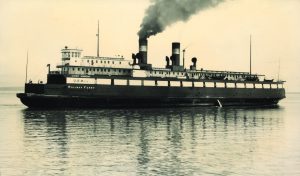
Although rails linked Mackinaw City and St. Ignace to the rest of the country, one final obstacle remained to efficient train travel: the Straits of Mackinac. To provide a rail link between Michigan’s peninsulas, in 1881 the railroads formed the Mackinac Transportation Company to operate rail ferries across the straits. Over the next century, the company employed several ever-larger rail ferries, which doubled as icebreakers to ensure year-round transportation. The largest of the ferries, the Chief Wawatam of 1911, could carry 26 railcars between Mackinaw City and St. Ignace.
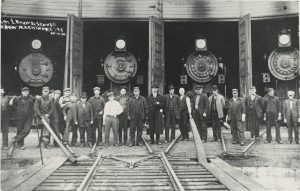
With the ferries linking both sides of the straits, Mackinaw City grew into a bustling railroad town. The Grand Rapids and Indiana built a large railyard south of Central Avenue in the downtown area. The Michigan Central built a depot near the ferry docks, which included the Wentworth House hotel. Both companies built large roundhouses to service their locomotives, and maintained ice houses in Mackinaw City to provide ice for dining cars and to cool sleeping compartments. Railroad employees, who worked as ticket agents, baggage handlers, car cleaners, locomotive crewmen, conductors, and members of the track crew, lived in a neighborhood south of the railyard. The rail ferries alone employed 120 men at one point.
In addition to freight, trains brought an increasing number of passengers traveling to the straits for vacation. To encourage summer travel, the railroads partnered with the Detroit and Cleveland Steamship Navigation Company to build the Grand Hotel on Mackinac Island in 1887. Each railroad might have three or four passenger trains per day to Mackinaw City.
As highways expanded and cars become more common following World War II, rail traffic declined. The Pennsylvania Railroad (which purchased the Grand Rapids and Indiana in 1918) stopped running trains to Mackinaw City in 1949, and the New York Central (which had acquired the Michigan Central) scaled back passenger service to summer weekends only in 1953. The completion of the Mackinac Bridge in 1957 created an efficient new way to connect the peninsulas. Between 1951 and 1960 the rail ferries saw a 54% decrease in traffic, reflecting the declining popularity of rail transportation in northern Michigan.
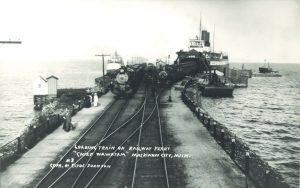
In 1976, Conrail, which purchased the railroad lines in the northern lower peninsula, stopped providing service to Mackinaw City. The Detroit and Mackinac Railroad took over the line leading east to Cheboygan. The state of Michigan formed the Michigan Northern Railroad to ensure connections to the west, and purchased the Chief Wawatam. The Michigan Northern enjoyed brief prosperity in the late 1970s, and passenger trains returned to Mackinaw City in 1982. However, in 1984 the railroad dock in St. Ignace collapsed, forcing the Chief into retirement. The Soo Line abandoned its St. Ignace branch in 1986, the same year that the Michigan Northern ceased operations. The Detroit and Mackinac continued running trains to Mackinaw City until 1990.
The Chief Wawatam, idle since 1984, was sold and cut down to a barge in 1988, and finally scrapped in 2009. All of the rail lines leading to Mackinaw City were scrapped, with the old roadbeds converted to biking and snowmobile trails. The roundhouses were demolished (the Michigan Central facility is now the location of the Burger King, while the Grand Rapids and Indiana roundhouse site is now a Shepler’s Ferry parking lot west of the Mackinac Bridge), and the railyard removed and replaced by the Mackinaw Crossings Mall.
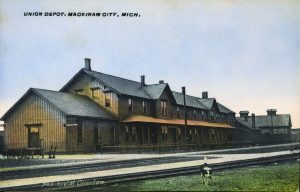
The railroads and ferries may be gone, but they aren’t forgotten. The Mackinaw City depot remains as a restaurant, the Chief Wawatam’s loading apron still stands, and Railroad Avenue hints at the railroad’s influence on village maps. Two of the Chief’s engines were preserved, along with numerous other artifacts from the ferry. Although the trains and ferries themselves may be gone, their legacies live on in photos, memories, and Mackinaw City’s continued role as a transportation center. Artifacts and photos related to the railroads and especially the Chief Wawawtam are on display at the local library and Old Mackinac Point Lighthouse.









